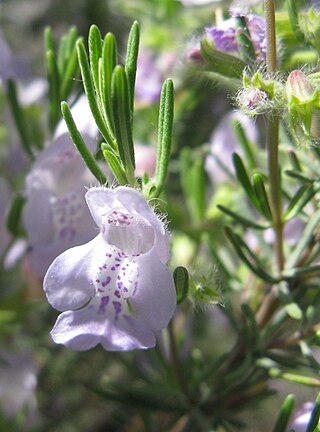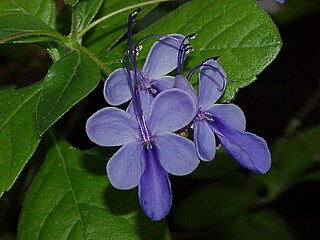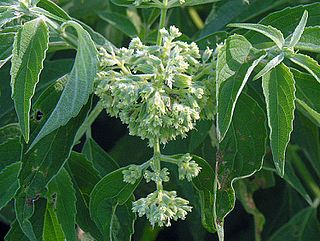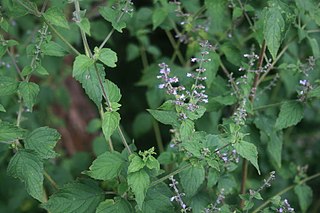
The Lamiaceae or Labiatae are a family of flowering plants commonly known as the mint, deadnettle or sage family. Many of the plants are aromatic in all parts and include widely used culinary herbs like basil, mint, rosemary, sage, savory, marjoram, oregano, hyssop, thyme, lavender, and perilla, as well as other medicinal herbs such as catnip, salvia, bee balm, wild dagga, and oriental motherwort. Some species are shrubs, trees, or, rarely, vines. Many members of the family are widely cultivated, not only for their aromatic qualities, but also their ease of cultivation, since they are readily propagated by stem cuttings. Besides those grown for their edible leaves, some are grown for decorative foliage. Others are grown for seed, such as Salvia hispanica (chia), or for their edible tubers, such as Plectranthus edulis, Plectranthus esculentus, Plectranthus rotundifolius, and Stachys affinis. Many are also grown ornamentally, notably coleus, Plectranthus, and many Salvia species and hybrids.

Leonotis is a genus of flowering plants in the family Lamiaceae. One species, Leonotis nepetifolia, is native to tropical Africa and southern India. It is naturalized throughout most of the tropics. The other species are endemic to southern + eastern Africa.

Basilicum is a genus of plants in the family Lamiaceae, first described in 1802. It contains only one known species, Basilicum polystachyon, native to Africa, Madagascar, southern Asia, New Guinea, Australia, and various islands of the Pacific and Indian Oceans.

Clinopodium is a genus of flowering plants in the family Lamiaceae. It is in the tribe Mentheae of the subfamily Nepetoideae, but little else can be said with certainty about its phylogenetic position.

Vitex is a genus of flowering plants in the sage family Lamiaceae. It has about 250 species. Common names include chaste tree or chastetree, traditionally referring to V. agnus-castus, but often applied to other species, as well.

Hyptis is a genus of flowering plant in the family Lamiaceae. These plants, known commonly as bushmints, are widespread in tropical North and South America, as well as parts of West Africa. There are 150 species, which may be annual or perennial herb to shrub. Recently, several genera were segregated from Hyptis.

Oxera is a genus of flowering plants in the family Lamiaceae native to Vanuatu and New Caledonia in the western Pacific.

Collinsonia is a genus of flowering plants in the family Lamiaceae. It is native to East Asia and eastern North America. It was named for the English botanist Peter Collinson (1694–1768) by Carl Linnaeus in Species Plantarum in 1753. It is in the tribe Elsholtzieae, a small tribe of only 5 genera. In order of their number of species, they are Elsholtzia, Mosla, Collinsonia, Perilla, and Perillula.

Conradina is a genus of flowering plants in the mint family, Lamiaceae. Its common name is false rosemary, or rarely, short leaf rosemary. There are 7 species of Conradina, all native to the southeastern United States. Conradina verticillata grows on the Cumberland Plateau in Kentucky and Tennessee. The other five grow mainly in Florida. All of the species are closely related and there is some doubt about whether they are all separate. Most species occupy xeric habitats with well-drained soils composed of white sand. The genus Conradina was established by Asa Gray in 1870. It was named for the American botanist Solomon White Conrad.

Rotheca is a genus of flowering plants in the family Lamiaceae. Estimates of the number of species in the genus vary from about 35 to as many as 60. Three of the species are native to tropical Asia, with the rest occurring in Sub-Saharan Africa. The type species for the genus is Rotheca serrata. It had originally been named Rotheca ternifolia, but this name is now considered illegitimate.

Viticoideae is one of seven subfamilies in the sage family, Lamiaceae.
Alvesia is a genus of plants in the family Lamiaceae, first described in 1869. It is native to central Africa.
Endostemon (keepsafe) is a genus of plants in the family Lamiaceae, first described in 1910. It is native primarily to eastern Africa, with some species in central and southern Africa, the Arabian Peninsula, Madagascar, and the Indian subcontinent.
- Endostemon albusA.J.Paton, Harley & M.M.Harley - Kenya, Tanzania, Mozambique
- Endostemon camporum(Gürke) M.R.Ashby - Kenya, Tanzania
- Endostemon ctenoneurusHarley - Kenya, Somalia
- Endostemon glandulosusHarley & Sebsebe - Ethiopia
- Endostemon gracilis(Benth.) M.R.Ashby - Kenya, Somalia, Tanzania, Yemen
- Endostemon kelleri(Briq.) Ryding ex A.J.Paton & Harley - Kenya, Somalia, Ethiopia
- Endostemon leucosphaerus(Briq.) A.J.Paton, Harley & M.M.Harley - Somalia, Ethiopia
- Endostemon membranaceus(Benth.) Ayob. ex A.J.Paton & Harley - Cameroon, Angola, Central African Republic
- Endostemon obbiadensis(Chiov.) M.R.Ashby - Somalia
- Endostemon obtusifolius(E.Mey.) N.E.Br. - from South Africa north to Angola and Tanzania
- Endostemon racemosusRyding, A.J.Paton & Thulin - Somalia
- Endostemon stenocaulis(Hedge) Ryding, A.J.Paton & Thulin - Somalia
- Endostemon tenuiflorus(Benth.) M.R.Ashby - eastern + southern Africa, Madagascar, Arabian Peninsula
- Endostemon tereticaulis(Poir.) M.R.Ashby - widespread across much of tropical Africa, also Yemen + Saudi Arabia
- Endostemon tomentosusHarley & Sebsebe - Somalia
- Endostemon tubulascens(Briq.) M.R.Ashby - Angola
- Endostemon usambarensisM.R.Ashby - Tanzania
- Endostemon villosus(Briq.) M.R.Ashby - central Africa
- Endostemon viscosus(Roth) M.R.Ashby - India, Assam, Sri Lanka
- Endostemon wakefieldii(Baker) M.R.Ashby - Kenya
Fuerstia is a genus of plants in the family Lamiaceae, first described in 1929. It is native to Eastern and Southern Africa.
- Fuerstia adpressaA.J.Paton - Angola
- Fuerstia africanaT.C.E.Fr. - East Africa
- Fuerstia angustifoliaG.Taylor - Tanzania, Angola, Malawi, Zambia
- Fuerstia bartsioides(Baker) G.Taylor - South Sudan
- Fuerstia dendrothrixA.J.Paton - Somalia
- Fuerstia raraG.Taylor - Angola
- Fuerstia rigida(Benth.) A.J.Paton - Angola
- Fuerstia ternataA.J.Paton - Tanzania
- Fuerstia welwitschiiG.Taylor - Angola

Hoslundia is a genus of flowering plant in the family Lamiaceae, first described in 1804. It contains only one known species, Hoslundia opposita. It is widespread across much of sub-Saharan Africa including Madagascar.

Hypenia is a genus of flowering plants in the mint family, Lamiaceae, first described as a genus in 1988. It is native to South America and southern Mexico.
- Hypenia aristulata(Epling) Harley - Goiás
- Hypenia brachystachys(Pohl ex Benth.) Harley - southern Brazil
- Hypenia calycina(Pohl ex Benth.) Harley - Brazil
- Hypenia concinna(Benth.) Harley - Tocantins
- Hypenia crispata(Pohl ex Benth.) Harley - Goiás
- Hypenia densiflora(Pohl ex Benth.) Harley - Brazil
- Hypenia durifolia(Epling) Harley - Brazil
- Hypenia gardneriana(Benth.) Harley - Brazil
- Hypenia glauca(A.St.-Hil. ex Benth.) Harley - Brazil, Paraguay
- Hypenia inelegans(Epling) Harley - Brazil
- Hypenia irregularis(Benth.) Harley - Brazil
- Hypenia macrantha(A.St.-Hil. ex Benth.) Harley - Brazil
- Hypenia macrosiphon(Briq.) Harley - Brazil, Paraguay, Bolivia
- Hypenia marifolia(Benth.) Harley - Brazil
- Hypenia micrantha(Benth.) Harley - Mato Grosso
- Hypenia paniculata(Benth.) Harley - Brazil
- Hypenia paradisi(Harley) Harley - Goiás
- Hypenia pauliana(Epling) Harley - Brazil
- Hypenia perplexa(Epling) Harley - Brazil
- Hypenia pruinosa(Pohl ex Benth.) Harley - Brazil
- Hypenia reticulata(Mart. ex Benth.) Harley - eastern Brazil
- Hypenia salzmannii(Benth.) Harley - Brazil, Guyana, Venezuela
- Hypenia simplex(A.St.-Hil. ex Benth.) Harley & J.F.B.Pastore - Brazil
- Hypenia subrosea(Harley) Harley - Goiás
- Hypenia violaceaMart.Gord. & S.Valencia - Guerrero, Oaxaca
Hyptidendron is a genus of plants in the family Lamiaceae, first described in 1849. The entire genus is endemic to South America.
- Hyptidendron amethystoides(Benth.) Harley - eastern Brazil
- Hyptidendron arboreum(Benth.) Harley - Guyana, Venezuela, Colombia, Ecuador, Peru, northwestern Brazil
- Hyptidendron arbusculum(Epling) Harley - Brazil
- Hyptidendron asperrimum(Spreng.) Harley - eastern Brazil
- Hyptidendron canum(Pohl ex Benth.) Harley - Brazil, Bolivia
- Hyptidendron caudatum(Epling & Játiva) Harley - Brazil
- Hyptidendron claussenii(Benth.) Harley - Minas Gerais
- Hyptidendron conspersum(Benth.) Harley - Bahia
- Hyptidendron dictiocalyx(Benth.) Harley - Goiás
- Hyptidendron eximium(Epling) Harley & J.F.B.Pastore - Mato Grosso
- Hyptidendron glutinosum(Benth.) Harley - Brazil, Bolivia
- Hyptidendron leucophyllum(Pohl ex Benth.) Harley - southern Brazil
- Hyptidendron rhabdocalyx(Mart. ex Benth.) Harley - southern Brazil
- Hyptidendron rondonicum(Harley) Harley - Brazil
- Hyptidendron unilaterale(Epling) Harley - southern Brazil
- Hyptidendron vauthieri(Briq.) Harley - southern Brazil
- Hyptidendron vepretorum(Mart. ex Benth.) Harley - Minas Gerais

Rhaphiodon echinus is a species of flowering plant in the family Lamiaceae, endemic to eastern Brazil. It is the only known species in the genus Rhaphiodon, first described as a plant genus in 1844.

Nepetoideae is a subfamily of plants in the family Lamiaceae.

Cantinoa is a genus of flowering plants in the family Lamiaceae. It is native primarily to New World, with some species introduced in the old world.















